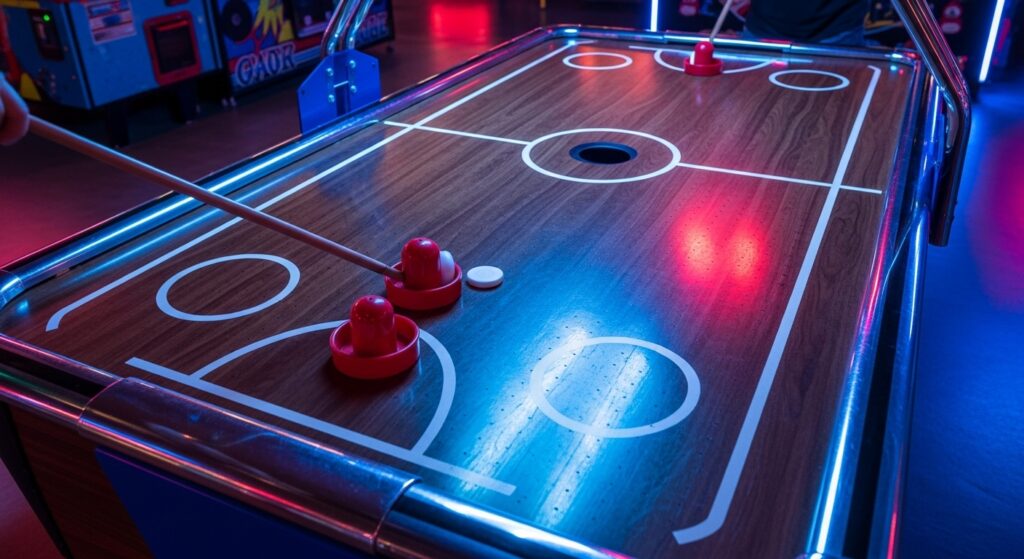In today’s fast-paced digital age, where entertainment is often confined to screens and virtual worlds, one classic game continues to bridge the gap between skill, connection, and competition — the air hockey table. More than just a game, the air hockey table represents an experience that unites people through shared laughter, reflexes, and strategy. Whether placed in a family game room, office break area, or community center, this timeless fixture has evolved into a symbol of interaction, teamwork, and friendly rivalry.
This article explores the cultural significance of the air hockey table, its evolution from arcade novelty to household staple, and why it continues to inspire connection and creativity in a world increasingly driven by technology.
The Origins: From Arcade Innovation to Household Favorite
The story of the air hockey table begins in the early 1970s, when a group of engineers at Brunswick Billiards sought to create a new kind of game that merged engineering precision with pure fun. Their innovation — a frictionless playing surface powered by tiny air jets — allowed the puck to glide effortlessly, creating a fast-paced and thrilling experience unlike any other.
Initially designed for arcades, the air hockey table quickly gained a cult following. Its mix of simplicity and speed appealed to players of all ages. Soon, it wasn’t just a game of chance or strength, but one of strategy, focus, and coordination. Over time, the table found its way into homes, schools, and offices — transforming from an arcade attraction into a social centerpiece.
A Modern Classic: Why the Air Hockey Table Still Captivates
Decades later, the air hockey table remains as relevant as ever. Its enduring appeal lies in its ability to balance nostalgia with excitement. While technology has revolutionized gaming, air hockey offers something rare: face-to-face interaction and genuine engagement.
Modern air hockey tables now come in a variety of designs — from LED-lit professional models with electronic scoring systems to compact, foldable versions for smaller spaces. Yet, no matter the style, the experience remains universal: a thrilling test of reflexes, anticipation, and connection.
For families, it offers bonding time that transcends generations. For coworkers, it provides a playful outlet for stress and team building. For competitors, it’s a fast, fair test of skill and concentration.
The Social Impact: Building Bonds Beyond the Game
What makes the air hockey table so special isn’t just the game itself — it’s the way it brings people together. In an era of digital isolation, this physical, interactive experience encourages genuine human connection.
-
In Homes: Families use air hockey as a way to disconnect from screens and reconnect with one another. It’s a tool for laughter, learning, and light-hearted rivalry.
-
In Offices: Many companies now include air hockey tables in their break rooms to foster collaboration, relieve stress, and encourage creativity. A five-minute match can do wonders for morale and communication.
-
In Communities: Community centers and youth clubs use air hockey to engage people of all ages. It promotes inclusivity — no special skills or expensive gear required, just enthusiasm and energy.
In each setting, the air hockey table acts as more than just a game. It becomes a platform for dialogue, teamwork, and shared memories.
The Psychology of Play: Strategy and Skill Development
Behind every fast-paced rally on the air hockey table lies a world of cognitive and physical benefits. The game challenges players to develop quick thinking, spatial awareness, and fine motor skills. It’s also a powerful way to enhance focus and adaptability — two traits essential in both gaming and life.
-
Reflexes and Coordination: Constant movement trains the brain and body to react in milliseconds.
-
Strategic Thinking: Players must anticipate their opponent’s moves, plan shots, and manage defense — all in real time.
-
Stress Relief: The game’s rhythm provides a healthy outlet for energy and emotion, helping reduce anxiety.
Researchers have long recognized that play, especially interactive play like air hockey, boosts mental agility and social intelligence. In that sense, the air hockey table isn’t just entertainment — it’s a form of cognitive training disguised as fun.
Air Hockey and Innovation: From Recreation to Competition
Over the decades, air hockey tables have also evolved into a legitimate sport with global appeal. Professional leagues, tournaments, and championships have turned casual players into skilled athletes. The game’s governing body, the United States Air Hockey Association (USAA), even organizes official competitions where players showcase reflexes and precision that rival professional athletes.
Technological innovation has also enhanced the experience. Some modern air hockey tables feature digital scoring, LED effects, and even AI-assisted training modes. Smart tables can now analyze puck speed, track performance, and suggest practice drills — merging traditional play with cutting-edge technology.
These advancements highlight the air hockey table’s ability to adapt to modern tastes while staying true to its core essence: connection through competition.
Design Evolution: Crafting an Experience
Beyond gameplay, the design of air hockey tables has become an art form. High-end tables now integrate sleek wood finishes, stainless steel components, and customizable LED lighting. Some are designed as statement pieces for luxury homes or entertainment lounges, while others focus on portability and affordability.
The design evolution reflects a broader trend — consumers today seek experiences, not just products. The air hockey table embodies that shift. It’s no longer merely furniture or a toy; it’s a centerpiece of social spaces, designed to spark interaction, joy, and creativity.
Why the Air Hockey Table Belongs in Every Home
Incorporating an air hockey table into your space isn’t just about entertainment — it’s about fostering connection. In family settings, it encourages healthy competition and teamwork. In workplaces, it fuels creativity and camaraderie. And in social venues, it breaks the ice and invites spontaneous laughter.
Moreover, it promotes balance in modern lifestyles. At a time when digital fatigue is common, air hockey offers a tactile, real-world antidote — a reminder that fun doesn’t always require Wi-Fi.
Looking Ahead: The Future of Play and Connection
As society continues to evolve, the air hockey table stands as a powerful symbol of timeless connection. It represents more than nostalgia; it embodies the joy of human interaction, the thrill of strategy, and the simple magic of play.
The next generation of air hockey enthusiasts will likely see even more innovation — smart sensors, augmented reality integration, and eco-friendly materials. Yet, at its heart, the essence will remain unchanged: two players, one puck, endless excitement.
In a world where technology dominates our attention, the air hockey table reminds us of something fundamental — that shared laughter and quick reflexes are still the best ways to connect.
Conclusion
The air hockey table is more than a piece of furniture or a nostalgic relic. It’s a bridge between generations, a tool for learning, and a symbol of togetherness. Whether it’s sparking laughter in a family game night, inspiring creativity in a workplace, or building community in a social hub, its impact endures.
As we continue to seek balance between digital and physical worlds, the air hockey table remains a timeless reminder that the best games are the ones that bring us closer — not just to winning, but to one another.







